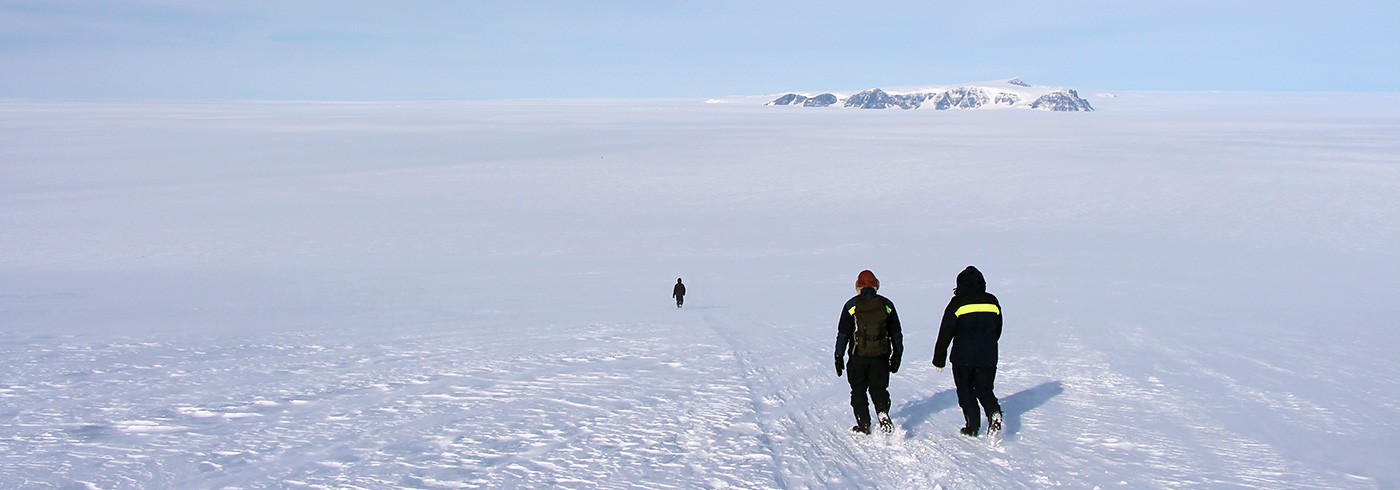When we are out in the field, we are a team of eight people based in a field camp. We have three large tents; two for sleeping and one that serves as a mess tent for cooking, eating and storing spare food and equipment. We sleep four persons to a tent, using a sleeping system that consists of a folding camp bed (to keep us off the cold snow beneath), a roll-mat and a sleeping bag. On the latest trip out we were camped on the ice sheet at about 1500 metres above sea level and we had night-time temperatures well below -20 °C so some of us have taken to using two sleeping bags, one inside the other, to keep warm. We also have a small toilet tent, pitched at a discreet distance from the other tents…
Our primary purpose is of course the science fieldwork but sometimes that can’t be separated from making sure the camp functions on a daily basis. That means we all have to take our part in the various daily camp activities such as melting snow for food and drink, cooking meals, washing up, refueling the trucks and snowmobiles, recharging batteries for the GPS, drills, Toughpads and various other communications devices that we have. Some days we are able to leave a person in camp to take care of a few of these tasks, but other days we are all out in the field so those tasks are left to the evenings.

The MAGIC-DML team crossing the ice on the way to Bowrakammen Ridge. Maybe you can see four little specks in the distance – that is us! Photo: Ola Fredin
A typical day might go like this. Two people get up before the others to have breakfast ready in the mess tent for 08:00. Then it is breakfast, making packed lunches, and boiling enough water to fill Thermos flasks and drinking water bottles for the day ahead. If the site we are interested in is relatively accessible we then head out in the cars and drive to the nearest access point. For the higher, less accessible sites we use the snowmobiles to get as close as we can. In both cases we always follow established routes across the ice to avoid obvious dangers like crevasses. We have all known routes loaded in the handheld GPS units and marked by waypoints, but sometimes the routes are old, maybe named something like ”German route to near Johnsonhogna 1986”. If so, we treat them with caution in case the ice conditions have changed since they were last travelled. We then proceed with caution when route-finding, scouting high-resolution satellite images and stopping to strap the ice radar system in front of the six wheeled car, driving very slowly to watch for crevasses. We can’t do that on the snowmobiles so instead we use 3m avalanche probes to check the snow depth and conditions as we go. Safety is paramount and if there is any doubt about finding a safe route across the ice, then we simply don’t go there.
When we have gotten as far as we can with the vehicles we then proceed on foot to the sites of interest, either in a rope team with ices axes and crampons if we are on snow and ice, or across rock and scree if the sites are accessible that way. Some days we cover quite large distances on foot, scouring the landscape for good sample sites where we can sample glacially polished and striated bedrock or find ”erratics” – boulders that have been transported by the ice sheet and dumped elsewhere in the landscape. Sometimes the walking is relatively easy, along broad ridges, but other times it is more difficult and can require roped-up scrambling along rocky ridges or outcrops.
Of course, no two days are the same when you are doing fieldwork in Antarctica but I hope this blog post gives a general flavour of our daily activities while we are in the field.








